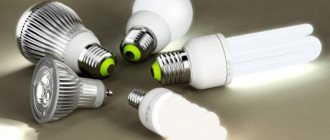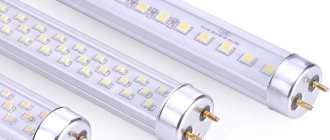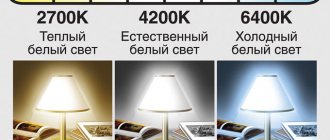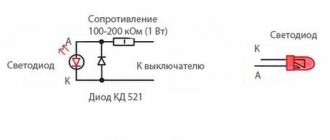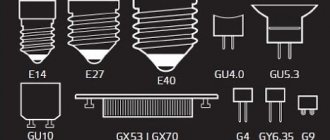Actual service life
Various figures are given regarding the service life of diode light sources, but we are always talking about tens of thousands of hours - from 20,000 to 50,000.
The maximum declared service life of LED light bulbs is 50 thousand hours. This figure is similar to 2083 days (more than 5 years) of continuous work. For comparison: an incandescent lamp lasts thousands of hours, and a fluorescent lamp lasts from 7 to 10 thousand.
Information regarding LED service life limits should be understood as indicative only, as the data is based on the results of accelerated wear tests. Such tests cannot be considered accurate; they are carried out at the level of individual components, and not the entire luminaire as a whole. It is not yet possible to test the actual service life of diode light bulbs experimentally - over many years - since they appeared on the market less than two decades ago.
Despite the promises of manufacturing companies, we should not forget about domestic realities. Power surges, poor-quality wiring and sudden power outages - all these factors have a detrimental effect on lighting fixtures. For street lighting, another negative point is added - weather conditions, which also shorten the life of the light bulb.
Main conclusions
The service life of LED lamps almost never corresponds to the time declared by the manufacturer. As a rule, the lamp lasts 3 years or a little more. There are ways to increase this period:
- reduce the supply voltage on the emitting crystal. This is an option that allows you to get good results, but is only available to specialists;
- organization of high-quality heat removal, periodic cleaning and care of the lamp. The beneficial effect is not so noticeable, but any user can perform these actions.
In addition, it is necessary to purchase products from reliable and well-known companies. Share your methods for increasing the service life of LED lamps in the comments.
Causes of breakdowns
There are several reasons leading to failure of an LED device:
- A sharp surge in voltage in the electrical network.
- Turning the light bulb on and off too often.
- Incorrectly designed lamp, resulting in overheating of the bulb.
- Problems with electrical wiring. Most often we are talking about incorrect switching and incorrectly selected conductor cross-sections.
- Physical damage to the lamp. This happens not only when there is a deliberate impact on the light bulb, but also due to, for example, regularly repeated vibration of building structures.
Fluorescent lamps with two, four or more lamps
If you have a two-lamp lamp, it is best to supply voltage to each connector with separate conductors.
When installing a simple jumper between two or more cartridges, the design will have a significant drawback.
The second lamp will light only if the first one is installed in its place. Remove it, and the other one will go out immediately.
The supply conductors should converge on the terminal block, where you will have the following connected in turn:
phase
zero
Earth
Before installing the lamp on the ceiling, it is necessary to apply voltage to it and check the operation of the lamps. If some contact comes loose, you can adjust everything here without climbing on top or jumping on stepladders.
LED lamps, unlike fluorescent lamps with a 360-degree view of the glow, have a directional flow of light.
But due to the ability to rotate around an axis by 35 degrees in the G13 base + by rotating the base itself, you can adjust them in the direction you need.
However, not all lamps have this base design. And sometimes you have to re-drill the cartridge mounts by 90 degrees.
If everything is in order, install the lamp in its place and enjoy economical and brighter lighting.
How to distinguish quality products from low-quality ones
The service life of an LED lamp is usually divided into effective and full. In the latter case, we are talking about the time when the light bulb completely fails. The effective period is the period during which the intensity of the lamp decreases by 30%.
Manufacturers of quality LED products report device life to industry standard L70 or LM70. For the first one it is equal to 30 thousand hours. This means that after the specified period (in hours), the brightness of the lamp will decrease by 30%.
Manufacturers of lower quality products usually indicate how long a particular light bulb lasts. In other words, such companies immediately talk about the entire service life of the product, keeping silent about the decrease in light intensity after some time. As a result, the consumer gets a false impression of the lifespan of the lighting device.
Note! The effective life of a light bulb depends on its color. For white LEDs, the calculation period is 10 thousand hours, for red, blue, green and yellow - approximately 25 thousand hours.
It is also recommended to pay attention to the warranty period for the lamp. With round-the-clock operation, about 9 thousand hours of lamp life are consumed annually. If a manufacturer only guarantees free repairs for a year, he is not confident in the quality of his products. If the warranty period is from 3 to 5 years, the likelihood of purchasing a high-quality light bulb increases.
Tech blog
(Last Updated On: 11.11.2021) As a rule, in LED lamps the operating current of the LEDs is greatly overestimated, and therefore the LEDs degrade and fail after a year or two. Some lamps, after repair and reduction of the current by 15-20%, work for a long time, but some fail again, since the LEDs are severely degraded, and the current can be reduced immediately by 40-50%. The luminous flux from the LED, when reduced from the limit current to the nominal current, drops not by 2, but by 1.5 times, which means the brightness of the lamp will not decrease by 2 times.
In lamps ECO-C37 3.5W 4000K E14 at 220V/50Hz 1244 with a parametric (unstabilized) power supply based on a step-down capacitor 0.62 μF (624 inscription and 400 ~) round bars S5-C37 3030 4-27.8 mm are used with 4 LEDs at 15.8V, 55mA 0.87W, resulting in 63V, 3.5W. It is necessary to reduce the capacity of the step-down capacitor to 0.47 microfarads (474) and the operating voltage to 400~ or 250~, respectively. Thus, the operating current of 4 LEDs will drop from 55 mA to 42 mA, the voltage from 63 to 58 Volts and the heating of the entire lamp will be significantly reduced. Power will drop by 27%.
In 5.4W lamps on AC 220V with a parametric (unstabilized) power supply based on a step-down capacitor of 1.3 microfarads (135 inscription and 400~), 10 LEDs in series are used at 6V, 90mA 0.54W, resulting in 60V, 5.4W. It is necessary to reduce the capacity of the step-down capacitor to 1.0 µF (105) and the operating voltage to 400~ or 250~, respectively. Thus, the operating current of 10 LEDs will drop from 90 mA to 60 mA, the voltage will drop from 60 to 56 Volts and the heating of the entire lamp will significantly decrease. Power will drop by 30%.
In Ecola A50 LED 7W lamps on AC 220V with a parametric (unstabilized) power supply based on a step-down capacitor 1.1 microfarads (115 inscription and 400~), 40 LEDs in series are used at 3V, 57mA 0.54W, resulting in 120V, 6.6W. It is necessary to reduce the capacity of the step-down capacitor to 1.0 µF (105) and the operating voltage to 400~ or 250~, respectively. Thus, the operating current of 40 LEDs will drop from 57 mA to 52 mA, the voltage will drop from 120 to 114 Volts and the heating of the entire lamp will significantly decrease. Power will drop by 10%.
The 3.5W Feron LB-40 E27 2700K lamps for AC ~220-240V based on the BP3122 chip driver (8 legs) and a 12x12x10mm transformer use 6 series (3 strips)-parallel (2 LEDs per strip) LEDs turned on at 3.13V 85mA , 0.3W. The LEDs are supplied with 9.4V, 170mA, 1.6W. To reduce the current, you need to increase the resistor from 1 to 2 leg CS (BP3122) from 2.2 ohm to 2.7 ohm by replacing or soldering in series R50 - 0.5 ohm resistor. Power will decrease by 19%. The operating voltage on the LEDs will drop to 9 Volts, the current to 140mA, respectively, for one LED 3.0V, 70mA, 0.21W. The LED board says 3WG45B.
In 5W lamps on AC 85-265V based on the BP3102 chip driver (8 legs) and a 10x10x10mm transformer, 10 series (5 in a group)-parallel (2 groups) LEDs connected at 3.1V 90mA, 0.3W are used. Each strip has 2 LEDs from different groups. For 2 groups of LEDs there is 15.4V, 180mA, 3W. To reduce the current, you need to increase the resistor on the 4th leg of the CS (BP3102) from 2.2 ohm to 3.2 ohm by replacing or soldering in series 1R0 - 1 ohm resistor. Power will decrease by 32%. The operating voltage on groups of LEDs will drop to 15.2 Volts, the current to 120 mA, respectively, for one LED 3.0 V, 60 mA, 0.2 W. The LED board says BL-5650.
In 5W lamps on AC 85-265V based on the BP3102 chip driver (8 legs) and a 10x10x10mm transformer, 8 series (4 in a group)-parallel (2 groups) LEDs connected at 3.2V 110mA, 0.35W are used. Each strip has 2 LEDs from the same group. For 2 groups of LEDs there is 12.8V, 220mA, 3W. To reduce the current, you need to increase the resistor on the 4th leg of the CS (BP3102) from 1.8 ohm to 2.8 ohm by replacing or soldering in series 1R0 - 1 ohm resistor. Power will decrease by 36%. The operating voltage on groups of LEDs will drop to 12.2 Volts, the current to 140 mA, respectively, for one LED 3.0 V, 70 mA, 0.2 W.
In lamps 9W E27 4000K on AC 220V based on a current stabilizer - microcircuit BP2832 2832 (8 legs) a circle A60-2835-26 is used from 2 parallel lines of 13 LEDs connected in series, at 6.15V 57mA, 0.35W. All LEDs are supplied with 80V, 114mA, 9W. To reduce the current, you need to increase the 1R65 resistor to 1R8 or 2R0 ohms by replacing (I put 2 and 22 ohms in parallel, for a total of 1.8 ohms). Power will decrease by 9-18%, to 8W-7.5W. The operating voltage on groups of LEDs will drop to 78 Volts, the current to 52-47mA, respectively for one LED 6V, 52-47mA, 0.31-0.28W.
In lamps 10W E27 4200K on AC 230V FLL-A60-9-230-4K-E27 based on a current stabilizer - microcircuit BP9916C 9916C (8 legs) a circle A60-2835-1W-10C of 10 LEDs connected in series is used, at 8.9V 90mA, 0.8W. All LEDs are supplied with 89V, 90mA, 8W. To reduce the current, you need to increase the parallel-connected resistors 5R9 and 6R8 ohm, to 5R9+2R2 and 6R8 - from the calculated 3.15 ohm to 3.7 ohm by replacing or soldering in series with the 5.9 ohm another 2.2 ohm resistor. Power will decrease by 17%, to 7W. The operating voltage on groups of LEDs will drop to 87.6 Volts, the current to 79 mA, respectively, for one LED 8.76 V, 79 mA, 0.7 W.
In 11W lamps on AC 220V based on a current stabilizer - BP9918C 9918C microcircuits (3 legs) 18 series-connected LEDs are used, at 11V 55mA, 0.6W. All LEDs are supplied with 200V, 55mA, 11W. To reduce the current, you need to increase the parallel-connected resistors 10 and 12 ohms, to 20 and 12 ohms (middle leg CS BP9918C) - from the calculated 5.5 ohms to 7.5 ohms by replacing or soldering another 10 ohm resistor in series with the 10 ohm one. Power will decrease by 28%, to 8W. The operating voltage on groups of LEDs will drop to 180 Volts, the current to 44mA, respectively, for one LED 10V, 44mA, 0.44W.
In lamps 12W at 220V 50Hz, 4000K E27 based on a current stabilizer - BP2833A 2833A chips (8 legs) are soldered on the L2029-03-40 board 23
series-connected LEDs, 3.2V 162mA, 0.52W. All LEDs are supplied with 73.6V, 162mA, 12W. To reduce the current, you need to increase the parallel-connected resistors 2R10 and 2R70 ohms, to 2R10 and 3R2 ohms (8th leg BP2833A) - from the calculated 1.18 ohms to 1.26 ohms by replacement. Power will decrease by 8%, to 11W. The operating voltage on groups of LEDs will drop to 73 Volts, the current to 150mA, respectively, for one LED 3.17V, 150mA, 0.47W.
Cosmos AC 220V 3W lamps based on a 200mA current stabilizer - BP2812 chip (8 legs) (GL-0AC5W_V2.0 board) use 10 series-connected LEDs, 30.7V 90mA, 2.8W, T2-P45-3W board. From the laboratory power supply I set 31.5V and these LEDs consume 50mA and shine weaker, which indicates a non-standard... In the circuit with an oscilloscope, the voltage waveform is 31 V, and there is pulsation up to the green choke..
In lamps with Ali 15W Warm White 220V RoHS based on a current stabilizer 2 MBI1802 chips (board D44-22P-01 3611E), 22 LEDs connected in series are used, divided into 16 and 6 chips. On the LEDs 38V and 109V are constant, respectively, the current is 57mA, 8.5W, in the middle on the U1 and U2 microcircuits 43V, a total of 190V. On one LED 6.7V, 0.38W. The mains consumption was ~230V, 62mA at alternating time. Attention, this lamp on the camera flickers a lot ! Be sure to solder a capacitor from 4.7 uF to 10 uF at 400V after the diode bridge and there is plenty of space in the base for the capacitor. After soldering the connector, the current increases to 92mA and the LEDs will burn out in 5 seconds. To reduce the current, you need to solder two 15 Ohm resistors on 1802 microcircuits instead of R1 and R2 of 13 Ohms each (the current will drop to 50mA), if the high flickers and do not solder the connector, or 23 Ohms each (you can solder the resistors while standing in series for a length of two 10 Ohm) (the current will drop to 52mA) if you solder the connector.
In Ming & Ben 18W 6500K 220V-240V 50/60H RoHS lamps based on 2 current stabilizers - 2 JZ1009AE chips (8 legs) (board D49-18P-01 29045B 2019-D, if you want to see an analogue, google D44 -22P-01) apply 18
LEDs from
6 consecutive sections of 3 parallel LEDs at 162V 110mA, 18W (In the circuit you can measure only the pulse voltage after the diode bridge 200V, and the open circuit voltage of the LEDs 50V, and on each LED section 27V), respectively for one LED 27V , 37mA, 0.99W.
To reduce the current, you need to increase 2 resistors R1 and R2 from 10 Ohms to 15 Ohms (between 1 leg and 2-4 legs of JZ1009AE) - by replacing or adding 5.1 Ohm resistors in series. Power will decrease by 33%, to 12W. The operating voltage on 1 section of LEDs will drop to 26.5 Volts, the current to 74 mA, respectively, for one LED 26.5 V, 24.6 mA, 0.66 W. For reference, the lamp consumed from ~220V 81mA 18W before the modification and 54mA 12W after. These lamps do not have a capacitor, so they flicker. In ASD LED-A60 E27 lamps, 20W 4000k 230V/50Hz 0.150A 0.150A 4690612004204 Light flow 1800 lm service life 30000 hours based on the current stabilizer DO 9607SA (8 legs) (N11-A65T-9607 COMP
LEDs connected in series at 134V 91mA, 12.2W. To reduce the current, you need to increase the resistor 4R3 to 8R2 ohms (between the 1st leg and the 8th leg of the 9607SA) - from 4.3 ohms to 8.2 ohms, the total resistance of the two setting resistors 3R6 and 4R3 = 1, 96 Ohms will increase to 3R6 and 8R2 = 2.5 Ohms. Power will decrease by 22%, to 9.3W. The operating voltage on the LED sections will drop to 131 Volts, the current to 71 mA, respectively, for one LED 5.7 V, 71 mA, 0.4 W. In this lamp, failed LEDs can be safely short-circuited, since the LEDs are switched on only in series.
In lamps Cosmos basic A65 E27 25W 4500K 220V/50Hz 0.100A model LED25wA65E2745 luminous flux 2100 lm service life 25000 hours based on a current stabilizer - HA5836AE chips (8 legs) (board N018082 V1.1) are used 22
LEDs (11 serial sections of 2 LEDs in parallel) at 99V 176mA, 17W, board A65Y 2P11S N018080A (and N018082). To reduce the current, you need to increase the 1R07 ohm resistor to 1R30 (between 7.8 leg and 1 leg of the HA5836AE) - from 1.07 ohm to 1.3 ohm by replacing it with 1R3 or 1R0 and 0R3 ohm. Power will decrease by 19%, to 14W. The operating voltage on the LED sections will drop to 98 Volts, the current to 146 mA, respectively, for one LED 8.9 V, 73 mA, 0.65 W. For reference, the lamp consumed from ~220V 105mA 23W before the modification and 70mA 15W after.
You need to understand that if “if you please” in one of the sections of three parallel LEDs one LED fails, then the current will flow through the remaining two as through three and you need to reduce the current by 1.5 times (so that it is the same as before), and to lower it, it is necessary by 2.2 times, or the weaker one of the two will burn out first, and immediately after it the third, because all the current will flow through it. Lamp manufacturers make circuits that are guaranteed to die and are as unrepairable as possible.
In the VARTON EB40-095-0-280-2180 213L luminaire there are 4 strips VARTON EB 18-222-1-12 9W DC27V DW - format 9 pairs = 18 LEDs = 4×18=72 LEDs, board JBT-IW0401-006 REV 2.1 20130715, chip IW3623-00, capacitors 33uFx450V and 50v220uF x 2 pcs, transformers JBT-IW0401-29V, JBT-IW0401-EE16, inductor UU9.8-40mH, transistors D13007, X13001, 7N65A, dual diode SFF1004. The LED strips received 28.7V 1.14A, 32.7 Watts. Accordingly, per LED 3.2V, 142mA, 0.45W. To reduce the current, you need to remove R36 - 3.6 Ohm (there are 4 pieces of R25 R34 R26 R36 in parallel - 3R30, 3R60, 3R30, 3R60) - the current will drop to 0.86A, voltage to 27.7V, power to 23.8 W, and the brightness will drop by 27%. If 2R2 - 2 pieces are soldered in series to R25, then the current will drop to 0.98A, voltage to 28.1V, power to 27.5W, and brightness by 16%. When repairing the lamp, a dried out C16 47uFx25V was found, symptoms of failure after 7 years of operation - a gradually increasing delay before lighting, then stopped turning on completely.
The street lamp START LED FL20W42 20 W IP65 board YDZ220 14LED housing YTZ-3.1-00017 SL-A-2-1 uses two RM9001E microcircuits with 22 Ohm resistors RS1 and RS4 - increase each to 33 or even 44 Ohms - the power will drop up to 15 or even up to 10 W - the flashlight will work for a long time. The flashlight on this chip does not have a capacitor, so it flickers.
Cooling:
Also, in lamps with a massive aluminum radiator between it and the round LEDs, there is often no white heat-conducting paste KPT-8; it is advisable to apply it.
If it is not dangerous and it is possible to disassemble the lamp, then it is advisable to remove the plastic or glass glass and heat the glass by turning on the lamp)) - this will provide additional cooling, and with the disappearance of the plastic it will slightly increase the luminous flux, but will give a bluish tint and point light sources will be blinding eyes when the lamp hits the visual area.
If it is possible to improve the cooling of the lamp much better by installing it horizontally, in an always cold place, or by disassembling it into components and by dispersing the heated components or installing them on massive radiators, then you can reduce lamp consumption not by 30%, but by 10-15%. . At the factory, the lifespan of the lamp is precisely calculated at the level of 1 year - cheap, 2 years - average, 3 years - expensive, so it is important to make sure that the light does not shine brightly, but for a long time. For brightness, just install more lamps.. If you do not reduce the operating current, then over time both LEDs and capacitors will degrade..
Repair:
The same thing needs to be done in the process of repairing failed lamps, in which LEDs most often burn, and capacitors less often swell. In lamps with a sequential circuit for switching on the LEDs, we short-circuit the burnt ones (if there are two groups in series, then the same number of LEDs should remain in each), in parallel lamps we replace all the extinguished LEDs with whole ones (alas, or the group will not work, but you can wisely short-circuit in each group equally), and be sure to reduce the current (because all the LEDs are slightly degraded or in circuits without a current regulator, the current increased after short-circuiting the LEDs).
Calculation file 1R2
Leave comments on the file, who needs to calculate what..
Tags: LED driver, 9918C, BP3102, iW3623, energo efficiency, LED lamp, Reducing brightness, How to reduce brightness, Reducing luminosity - increasing service life. Lifespan.
Is it worth buying cheap Chinese lamps?
Many buyers are tempted by the low prices of Chinese products. However, buying such lamps contains many unpleasant pitfalls:
- No warranty. It is rare that an online seller provides a guarantee on the goods they sell. Even if the product is initially defective, it will be difficult to prove anything and exchange is not always possible.
- Exaggerated promises. Chinese-made products are often offered with tempting technical characteristics that are not confirmed in practice.
- Poor quality LEDs. Almost all Chinese-made LED light bulbs are offered without specifying a specific manufacturing company. Such products are assembled from cheap components and are often initially defective.
- Insufficient lighting spectrum. It is not recommended to use cheap lamps for home use. If you have already purchased such a device, it is better to install it for street lighting. Poor quality light negatively affects vision, especially children's vision.
- Low color rendering index. Low-quality LEDs produce insufficient luminous flux. The ability to perceive colors in this case is reduced many times over. This is an almost universal drawback of Chinese products.
- The presence of powerful pulsations. This figure should not be higher than 20%, which corresponds to a hundred flashes every second. When there are too many of them, the eyes quickly get tired, which adversely affects not only vision, but also the general condition of a person. Chinese LED lamps have a ripple rate of 30%.
- Bad reputation. Reviews of cheap electrical goods from China are most often negative.
PCB design
To avoid any potentially dangerous conductive path between the fixture body or heatsink and the LED pads, it is very important that the printed circuit board (PCB) is designed to maintain adequate creepage distances from the copper pads and the edges of other metal parts. connected to the body. In Figure 7, any copper path close to the edge must be within insulation distance. The minimum recommended distance is 3mm, even though the recommended distance is usually 5-7mm whenever possible.
Another important factor in PCB design is the copper traces near the screws. The distance should be calculated based on the screw head diameter, not the PCB hole. When wires are connected on a PCB instead of using a connector, it is very important that the cable wire insulation covers the soldering pad and does not reduce the creepage distance.
The PCB used for LED panels is usually aluminum based. Aluminum and copper are separated by a dielectric material that provides electrical insulation between both metals. This dielectric must be thin enough to ensure good heat transfer from the LED to the body of the device, but thick enough to provide sufficient electrical insulation. Typically, the aluminum on the PCB is in direct contact with the heat sink of the fixture, so the unique insulation is provided by the dielectric on the PCB. For this reason, it is essential that the PCB supplier guarantees a minimum PCB breakdown voltage value for all PCBs supplied.
If any of the PCB's creepage paths or breakdown voltages are not sufficient to withstand surges in the environment, there is a risk of arcing and flashing, and damage to and from the LED due to EOS (Figure 7) .
Figure 7: If any of the leakage paths or breakdown voltages of the PCB are insufficient, the risk of damage to the EOS is very high
Is it possible to calculate the service life of a lamp in advance?
There are no reliable methods that allow you to know in advance the service life of an LED light bulb. Therefore, when purchasing a lamp, it is recommended to pay special attention to the reputation of the manufacturer. This advice is especially relevant when it comes to purchasing an expensive device. One of the most effective ways to learn about a company's reputation is to read reviews on forums where real people discuss the advantages and disadvantages of a company's products.
What do we change for what?
Halogen (halogen?) lamp. Halogen lamps operate on the principle of incandescent lamps. In them, light is emitted by a hot tungsten filament. The internal cavity of the flask is filled with a special chemical composition that prevents rapid wear of the spiral and failure of the product.
In everyday life, they are powered by 12-24 volt current sources. They are used in conjunction with electronic converters (transformers) that reduce the voltage to the required value.
Low voltage halogen lamp 12V and spotlight for it
LED bulbs. These are assemblies made from an array of semiconductor elements that can glow under the influence of electric current. All emitters are connected in series-parallel with each other and are designed for certain power parameters.
LEDs operate only on direct current. In order to adjust a standard household network to the specified values, special electronic devices are used - drivers.
LED lamp with g4 socket
Ways to extend service life
To ensure that the lamp lasts as long as possible, it is recommended to adhere to the following rules:
- Wipe the surface of the lamp from dust. Periodically clean the light source with a vacuum cleaner. In this case, detergents should not be used, as they can damage the light bulb.
- LED strips cannot be glued directly to furniture or wallpaper. An aluminum profile is better suited for this. This material is capable of absorbing excess thermal energy.
- The lamp will work much longer with proper heat dissipation. Otherwise, the so-called “thermal degradation” of the light diode is inevitable.
- Use a dimmer. This device is a light switch with adjustable brightness. The device does not greatly affect energy savings, but significantly extends the service life of lighting devices. Its main advantage is the reduction of inrush currents. They are the main cause of lamp burnout.
An LED lamp can serve for many years, but taking into account the realities of domestic conditions of use, lamps rarely work longer than 3-5 years. At the same time, their service life can be extended if you strictly adhere to the operating rules.
Which light bulbs are suitable for conversion?
In order for a converted lamp to last for a really long time, it is better to take a known high-quality model. For example, products from the following manufacturers:
- Osram;
- Philips;
- Gauss;
- ASD;
- Camelion.
Philips lamp (one of the best for remodeling).
It is worth considering the models of Russian companies, since they are already adapted to the operation of local power grids and are therefore more resistant to voltage surges.
Lighting principles
The lighting device is used to illuminate a whole room or a separate area. This is the basic principle of building light. Light affects the perception of the interior of the house. The light falling from the lamps must perform the following tasks:
creating a suitable atmosphere for work; correct lighting of interior details for a decorative effect; focus a person’s attention on the advantages of the room and hide its disadvantages; illuminate specific places for personal needs.
The location of the light source is of great importance for the distribution of illumination. A lamp in the center of the room provides radial illumination. The center will be clearly visible, but the corners will remain in the visual twilight zone.
The distribution of point light sources throughout the apartment or house allows you to provide light in any corner of the room
This method makes it possible to focus attention on specific objects. Local lighting has many useful properties, and table lamps help fill the lack of lighting
A table lamp allows you to illuminate certain areas of the room with high quality. This is an additional light source that is used for reading or working. They are also good as a night light.
Transformer replacement
The problems listed above can be easily eliminated: remove the transformer for halogen products and instead install a power supply with parameters suitable for the mounted group of LED lamps. It is necessary to consider not only the supply voltage (12 V), but also other characteristics. When choosing an element, focus on the total power of the connected lighting fixtures. If necessary, two or three transformers can be used.
These calculations are relatively simple: count the number of installed light sources in a group and multiply their number by the power of one (provided that you have chosen the same lamps). For example, if the power of an LED product is 2 W, there are 10 of them in a group, then the transformer must withstand a total load of 20 W (it is advisable to increase the parameter by 10%; the result will be 22 W).
When comparing halogen lamps and LED lamps, it becomes obvious that the power of the former is 2-3 times higher than the total load of the entire group of the latter. When buying a transformer for diodes, make sure that the dimensions of the electrical element approximately match the power supply for halogen lamps.



